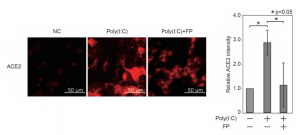A group from Hokkaido University, etc. has reported on changes in the expression levels of ACE2 and TMPRSS2 with agonists for Toll-like receptors (TLRs) and with Fluticasone Propionate (FP)
https://www.ncbi.nlm.nih.gov/pmc/articles/PMC8107375/
It is said that SARS-CoV-2 cell entry depends on two proteins present on the surface of host cells, angiotensin-converting enzyme 2 (ACE2) and transmembrane protease serine 2 (TMPRSS2). Authors has investigated effects of activation of innate immune signal path onto the expression levels of ACE2 and TMPRSS2, and also if there is any effect of FP administration on that.
As sample cells, primary human nasal epithelial cells (HNECs) were collected from the nasal mucosa. HNECs were stimulated by Poly(I:C), which is a double-stranded RNA (dsRNA) often used as a agonist for TLRs in a model of viral infection.
ACE2 and TMPRSS2 protein expression levels were evaluated by using immunofluorescent analysis. The ACE2 intensity in HNECs was significantly promoted by Poly(I:C) (a 2.884±0.505-fold change vs. untreated cells, p=0.003), but there were no significate changes in the TMPRSS2 expression levels. And, this Poly(I:C)-induced change in ACE2 was significantly suppressed by FP (a 0.405±0.312-fold change vs. Poly(I:C)-treated cells, p=0.044).
Further studies are required to evaluate whether FP suppresses SARS-CoV-2 viral cell entry in vivo.

